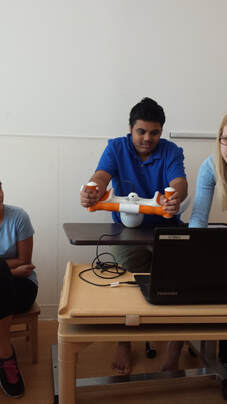Technology is my body extension...

I estimate millions of nebulous dendrites command my sensory motor machinations. Inside others, synapses are excited securely to potentials I dream in vain. In my sensory interface, I recognize that stimuli have thresholds. Most of my stimuli settings, having been both reduced in focus and increased in sensitivity, make it challenging to determine the source and duration of a stimulation. In the housing of these stimuli, I find my body connections are securing the input but not able to modulate their amplitude. Therefore, my body reads these stimuli in terms of frequencies and patterns. My motor memory becomes dependent on these frequencies to operate my body and new interpretation of these patterns is almost impossible. Motor coordination and planning of an event is subsequently delayed or nonexistent. This is why generalization of responses or communication in different environments is difficult at times.
The strategy I often use is to make an algorithm of sensory motor response in relation to sets of frequencies or patterns. My focus is dependent on acquiring and managing the streams or the channels of stimuli. In this algorithm I hyper focus on each stimulus then record its intensity. In this way, I use parallel processing or group processing. I cannot go in a sequential series as you do to focus. I ask myself…is the wavelength continuous or discrete? do I find a pattern?
Sensory patterns become superimposed and that forms my perception. Creating a motor response requires me to perceive the dominant stimuli in this superposition. I must direct mind and body to motor coordinate an appropriate reaction to those dominant stimuli. This does not always happen with intention.
It can take time to do this. I have an internal clock which is constantly changing, due to my alternate neural pathways. In having a superposition of sensory states, I am an inertial observer of time. Time is understood by a change in matter or motion in our human experience, by causality in spacetime. But I perceive time differently. My clock is unreliable, because the chaos of stimuli and my neural pathways prevent background synchronicity of space and time. Isn’t global synchronicity taken for granted by most neurotypical people? The quantum mechanics of autism continue to amaze me.
As a child my idea was to create a device to help people with autism communicate and sense their environment. I imagined a body cap and armor of sorts. I conjectured the design should include electrical innervation of connections arising in cerebral cortex and ending in tensile sense receptors. A computer chip could encapsulate the working memory. It was an ambitious dream.
Recently, diagnostic tools have developed that can measure nervous response and help build neurofeedback loops. I have used many biofeedback technologies that have been helpful. Some I have used in occupational therapy for visual motor coordination and others were BCI or brain-computer interface technologies to help with focus and attention. My Ipad is a portable communication tool I use alongside laminated boards to type to communicate. I hope in the future neural biofeedback mechanisms can be worked into communication and information technologies to make a holistic sensory experience for people like me.
The strategy I often use is to make an algorithm of sensory motor response in relation to sets of frequencies or patterns. My focus is dependent on acquiring and managing the streams or the channels of stimuli. In this algorithm I hyper focus on each stimulus then record its intensity. In this way, I use parallel processing or group processing. I cannot go in a sequential series as you do to focus. I ask myself…is the wavelength continuous or discrete? do I find a pattern?
Sensory patterns become superimposed and that forms my perception. Creating a motor response requires me to perceive the dominant stimuli in this superposition. I must direct mind and body to motor coordinate an appropriate reaction to those dominant stimuli. This does not always happen with intention.
It can take time to do this. I have an internal clock which is constantly changing, due to my alternate neural pathways. In having a superposition of sensory states, I am an inertial observer of time. Time is understood by a change in matter or motion in our human experience, by causality in spacetime. But I perceive time differently. My clock is unreliable, because the chaos of stimuli and my neural pathways prevent background synchronicity of space and time. Isn’t global synchronicity taken for granted by most neurotypical people? The quantum mechanics of autism continue to amaze me.
As a child my idea was to create a device to help people with autism communicate and sense their environment. I imagined a body cap and armor of sorts. I conjectured the design should include electrical innervation of connections arising in cerebral cortex and ending in tensile sense receptors. A computer chip could encapsulate the working memory. It was an ambitious dream.
Recently, diagnostic tools have developed that can measure nervous response and help build neurofeedback loops. I have used many biofeedback technologies that have been helpful. Some I have used in occupational therapy for visual motor coordination and others were BCI or brain-computer interface technologies to help with focus and attention. My Ipad is a portable communication tool I use alongside laminated boards to type to communicate. I hope in the future neural biofeedback mechanisms can be worked into communication and information technologies to make a holistic sensory experience for people like me.